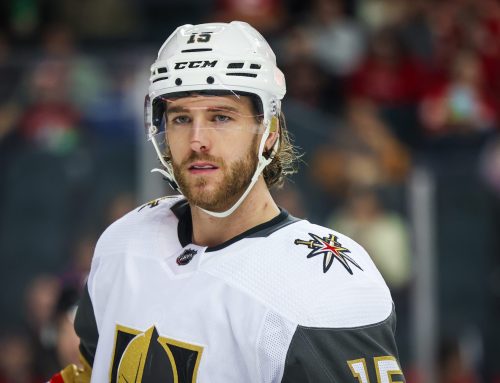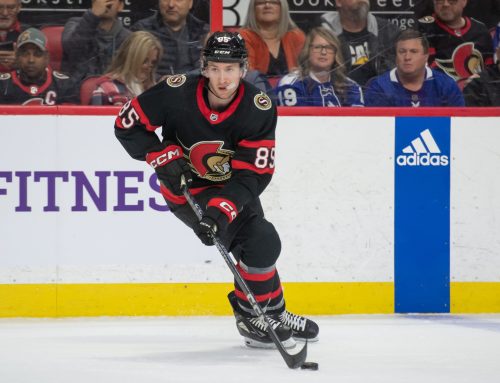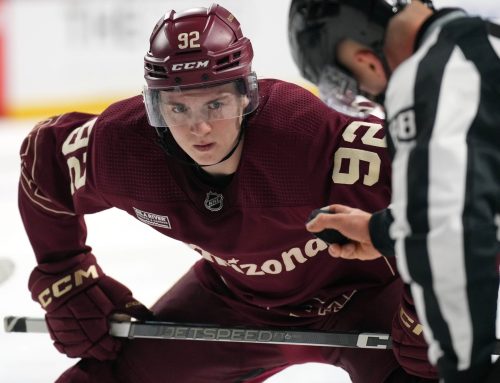Ramblings – What went right and wrong for PK units this year? (May 7)
Neil Parker
2016-05-07

A closer look at a number of penalty-kill units and a top-10 list of NYI-TB observations …
***
The Lightning-Islanders single bullet was underwhelming, at best.
Nikita Kucherov scored a weak goal on the short side to tie it up, and Game 5 was upon us quickly into overtime.
Better luck next year, Islanders fans.
Here are a few things I liked and noticed about Game 4:
1) How many Islanders have black eyes and/or are sleep deprived?
2) Please call more penalties like the second minor to Ryan Callahan, if for nothing else than for being annoying and stirring an empty pot.
3) Calling the second Ryan Callahan minor limited the silliness after the whistle slightly.
4) If Ryan Strome had a wooden stick, do you think that far-side chance would have gone in? His stick/blade looked awful flimsy, and players with his hands/skills used to always "bang those home."
5) Brian Boyle is an extremely effective player. A lot of buzz surrounds the fourth line from NYI, but Boyle is basically the PP-PK-SD pivot. SD = shut down.
6) Ben Bishop is better than Thomas Greiss.
7) Jonathan Drouin never lays up, and he visualizes scoring opportunities when the puck is on his stick. Most players hear their coaches in their heads. Drouin doesn't, and he has the upside you want to grab in all fantasy leagues — like three weeks ago.
8) Ryan Pulock has great wheels, and he could have a similar rookie impact as Colton Parayko had this past season. The size, the shot and the wheels are all there. Maybe even the offensive instincts.
9) New York can't win this series because of Jack Capuano's inability to coach this team.
10) The Islanders, despite inferior goaltender, could beat Tampa Bay with a better coach.
***
Four years ago, I created my Power Play Point Potential Rankings, and since they've undergone a number of tweaks and variations.
Currently the rankings are based on each team's power plays and penalty kills. They weigh shorthanded save percentage, penalty-kill percentage and shorthanded goals against per 60 minutes for the Defensive PPPP Rankings, and the Offensive PPPP Rankings are based on power-play shooting percentage, power-play percentage and goals per 60 minutes with the man advantage.
The rankings are especially helpful for daily games and pinpointing mismatches, but there is a lot of value in all fantasy formats. Knowing the best and weakest special teams units is beneficial, especially when you're able to track the peaks and valleys of each club throughout the season.
Logging the data and firing up the numbers is great throughout the year, as monitoring and analyzing why teams are rising and falling is where you gain a real edge in season. Personnel changes, injuries and other factors can quickly have a significant impact.
For example, as of October 27, Philadelphia ranked last in the league in the Offensive PPPP rankings and had a dead-last 3.0 GF/60 with the man advantage. As of November 12, Philly was the 28th-ranked club in the rankings with a 29th-ranked 3.9 GF/60.
In the December 14 Rankings, Philadelphia was up to 6.6 GF/60 and the 25th-ranked club. The Flyers finished the season with a 6.8 GF/60, and as the 16th-ranked team in the Offensive PPPP Rankings.
The Flyers topped out as the 15th-ranked team with a 7.1 GF/60 in the March 15 Rankings.
There are two reasons to highlight the Flyers: Shayne Gostisbehere's promotion and Jakub Voracek's late-season injury.
The numbers highlight the impact Gostisbehere had in the power play heating up, and then, how Voracek's injury and return to the lineup impacted the success in the final stretch.
Stepping back and comparing two seasons is helpful, too.
Today, I want to look at the significant changes in penalty killing from the 2014-15 season to 2015-16.
The five teams dropping the furthest in the Defensive PPPP Rankings from the 2014-15 season to 2015-16 were the Minnesota Wild, Colorado Avalanche, Ottawa Senators, New York Rangers and Winnipeg Jets. The five most improved teams were the New York Islanders, Buffalo Sabres, Washington Capitals, Anaheim Ducks and Edmonton Oilers.

Please note, the higher the ranking, the more difficult the matchup. For example, 30 is the most difficult.
Anaheim Ducks
The Ducks were the toughest matchup for opposing power plays this season, and the obvious statistical differences are in save percentage and the kill rate. However, the personnel had a number of changes, also.
Francois Beauchemin was out of the picture this year, and Sami Vatanen played more minutes. Additionally, Jakob Silfverberg and Andrew Cogliano both saw more ice time because Nate Thompson was limited to 49 games this season.
The difference was in nets. John Gibson had an otherworldly .930 save percentage while shorthanded, and Anton Khudobin was even better with a .941 mark through his seven appearances. Khudobin's mark paced the league and only Jeff Zatkoff's .939 Sv% was better than Gibson's Sv%.
As a team, Anaheim paced the league in all three weighted categories, but it is definitely interesting that Khudobin and Gibson were elite, whereas Frederik Andersen's .885 shorthanded save percentage was significantly lower, despite playing the same number of games as Gibson.
The easy analysis is to be cautious of Gibson taking a step back next season.
Buffalo Sabres
Coaching, an improved roster and a less-blatant tank made the Buffalo PK significantly better.
After Rasmus Ristolainen, the four players with the most penalty-kill minutes were David Legwand, Josh Gorges, Ryan O'Reilly and Brian Gionta this year. In 2014-15, the forward with the most shorthanded minutes was Zemgus Girgensons.
Plus, eventual-No. 1 Robin Lehner returned a rock-solid .928 shorthanded save percentage through his 19 games this season, which helps boost the ranking. Michal Neuvirth (.849) and Jhonas Enroth (.822), on the other hand, really hurt the ranking in 2014-15.
The improvement was tied to veterans playing a more signifcant role while shorthanded.
Colorado Avalanche
Interestingly, Francois Beauchemin played more shorthanded minutes than any other player for Colorado this season, and remember, he was a key subtraction in Anaheim's climb to the best penalty kill in the league.
Jan Hejda couldn't crack a lineup this season, but he did lead a respectable Avalanche penalty kill in minutes in 2014-15, which is extremely interesting. Also missingin 2015-16 was Ryan O'Reilly, who was previously cited as being a key contributor to turning the Buffalo PK around.
Brad Stuart was limited to just six games because of various injuries, too, and he was also a key cog for the 2014-15 PK. Marc-Andre Cliche played the most shorthanded minutes in the previous campaign among forwards, and he spent to the latest season with the New York Islanders organization.
What you have here is extensive changes. Beauchemin came in after — potentially — being a weak link in Anaheim, and solid penalty-killer O'Reilly is out of the picture, along with Stuart and Cliche.
Also, Semyon Varlamov dropped from a .941 shorthanded Sv% in 2014-15 to a .859 mark last season, which has to soak up significant blame. Even if the changes in front of him were significant, that is a below-average save percentage.
Edmonton Oilers
Similar to Buffalo, there was a new coach in town, but the biggest difference from the 2014-15 Oilers to the club iced last season with Cam Talbot.
Talbot's .898 shorthanded save percentage isn't a jump-off-the-page ratio, but only five teams posted a better mark last year. Anytime anything Oilers related is approaching a top-tier grade it's notable.
Talbot's performance is even more impressive given the complete upheaval of their penalty-killing unit. Matt Hendricks is the only player to have played significant minutes for Edmonton in consecutive seasons while shorthanded.
It is worth noting, though, Mark Letesu lead the Oilers in shorthanded ice time last season, so that stands to keep him fantasy relevant in cavernous leagues.
Ultimately, though, this was a coaching and goaltending upgrade. Oh, and maybe Edmonton wasn't tanking for the first time since 2006.
Minnesota Wild
The Wild went from the second-worst matchup in 2014-15 to the fourth-friendliest draw this season. The biggest difference is the 80-point drop in Devan Dubnyk's shorthanded save percentage (.928 to .845).
Kyle Brodziak and Jonas Brodin played the most forward and defensemen shortanded minutes in 2014-15,respectively, and Brodziak left for St. Louis, and Brodin played the fourth-most shorthanded minutes among blue liners this year.
Those are the significant differences, but ultimately, it was looming regression to Dubnyk's PK save percentage that made the difference. And circling back, it also reinforces the concern for John Gibson.
New York Islanders
There isn't a clear double-double combo in play here.
First, Casey Cizikas played a more significant role on the penalty kill this season, which further highlights why head coach Jack Capuano is overdue for unemployment — and I'm reserving comment/analysis/rant for another time.
Cizikas should have been eating all the PK time he could handle.
The second factor is Jaroslav Halak's .922 shorthanded save percentage compared to his .856 mark in 2014-15. A meeting in the middle is a fair projection for 2016-17, which shouldn't hinder the Islanders' PK too much.
There was a slight reshuffle of assignment (Travis Hamonic and Calvin de Haan played more minutes because they were healthy), which likely helped the results to a degree, but expecting Halak to post a number similar to Thomas Greiss' excellent .888 shorthanded save percentage is advised.
There aren't many chinks in the armor here.
New York Rangers
A limited dip in save percentage suggests the scoring chances had to be significantly better and easier to capitalize on. And given the limited roster changes, could the negative trend be chalked up to age-induced regression?
Kevin Hayes' shorthanded duties were removed this season and Carl Hagelin wasn't with the club, but otherwise, it was the same cast of characters killing penalties. Henrik Lundqvist's shorthanded save percentage dropped from .859 to .848, which isn't enough of a difference to tip the scales, right?
Wrong, kind of.
New York allowed 66 more shorthanded shots this season (275 vs. 341), which explains the save percentage remaining similar and the GF/60 increasing. It could also be argued — likely successfully — the age-related regression is legit.
Or are the Rangers just not very good, at all?
Ottawa Senators
It begins and ends with Andrew Hammond's historic run in 2014-15. He posted a .926 shorthanded Sv% in '14-15, and then returned a .789 mark through the same amount of games last year (23).
Craig Anderson's shorthanded Sv% only dipped from .885 to .865, which is hardly a difference maker over the course of a season.
Before laying all the blame on Hammond, though, it is worth noting David Legwand and Eric Condra were minute eaters for Ottawa while shorthanded in 2014-15 and weren't with the team last year.
Washington Capitals
Sometimes the numbers don't yield a lot of answers.
Braden Holtby actually had a worse shorthanded Sv% (.881 vs. .886) this year compared to last season, and the difference in penalty-kill percentage was just 1.4 points.
In terms of personnel, less Brooks Orpik, Troy Bouwer, Brooks Laich and Joel Ward in favour of more Matt Niskanen, Karl Alzner, Tom Wilson and T.J. Oshie obviously played a small role, but the swaps shouldn't be overstated, either.
Justin Peters and Philipp Grubauer were awful in 2014-15, but it wasn't enough to cover the entire gap, so chalk it up to Washington being the best team in the league during the regular season. And, expect Holtby to slightly statistically fade next year.
It isn't a spot to over analyze. Washington lapped the league this year.
Winnipeg Jets
What a mess.
Dustin Byfuglien played more minutes while some veterans played far less.
Goalie-of-the-future Connor Hellebuyck had the worst shorthanded Sv% (.826) over the past two seasons, yet he had the best five-on-five mark (.939). And that makes perfect sense, right?
Possession-killer Mark Stuart and suffering-partner Jacob Trouba have been the two minute eaters the past two seasons shorthanded, and in case your missed it, our boy SlimCliffy, outlined that situation earlier this week, and it cannot be spun positively.
One thing you will notice, though, is Winnipeg leaned on Andrew Ladd, Bryan Little and Blake Wheeler more frequently while shorthanded during the 2014-15 season than this past campaign.
Whereas this year, Dustin Byfuglien saw more shorthanded ice time than the year past, and Alexander Burmistrov received more shorthanded minutes than any other forward on the team. Adam Lowry ranked second among forwards with more than three times the minutes he played the year prior, for the record.
We've been killing the Winnipeg coverage of late, but for fantasy purposes, toss it up, spin it around, and we'll see where it falls in September, December and March.
What a mess.
***
After looking at these risers and fallers in penalty-kill proficiency, a few things stand out.
1) Lost veteran leadership and significant personnel change is detrimental.
2) One-hit-wonder goalies are just that.
3) Picking on sub-par PKs is a lot of fun in daily contests.
4) Be ready to downgrade a goalie sightly if a key penalty killer relocates.
***
Enjoy your weekend.
4 Comments
Leave A Comment
You must be logged in to post a comment.





 BOS
BOS OTT
OTT CBJ
CBJ CAR
CAR MTL
MTL DET
DET PHI
PHI WSH
WSH FLA
FLA TOR
TOR WPG
WPG SEA
SEA VAN
VAN CGY
CGY VGK
VGK CHI
CHI EDM
EDM S.J
S.J NYI
NYI COL
COL

I think it was very clear that Cappy wasn’t the coach to get the Islanders deep into the playoffs. After last season, he at least deserved a short leash, but mid-way through the season, when the Isles were treading water, he should have been let go, along with the other coaches. The system is broken….it doesn’t work. I think Snow has also punched his own ticket with he reluctance to make a change. It’s going to be a very busy off season in Islander country.
Another great read! Loved the PPPP analysis…as well as every other post on this site.
Thanks, Burnsy.
Phil — I can’t exactly put my finger on it, but Capuano’s usage of Strome, separating Okposo and Tavares for most of the season and their underachieving campaign leave a lot to be desired.
I agree, it was a head scratcher for sure.